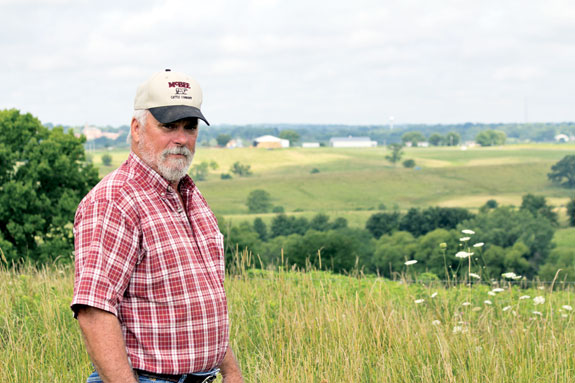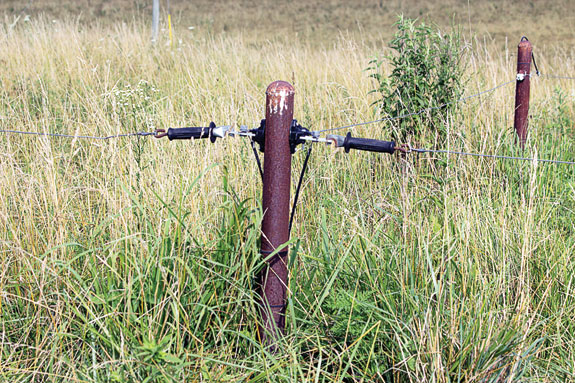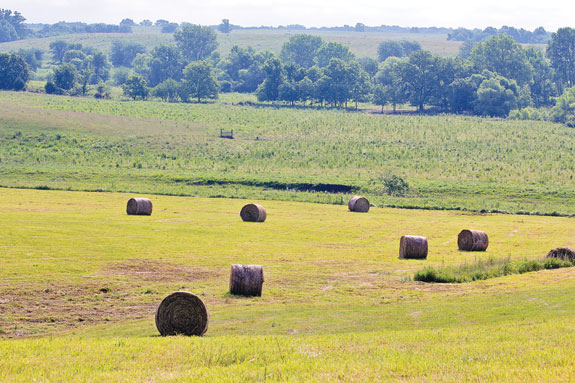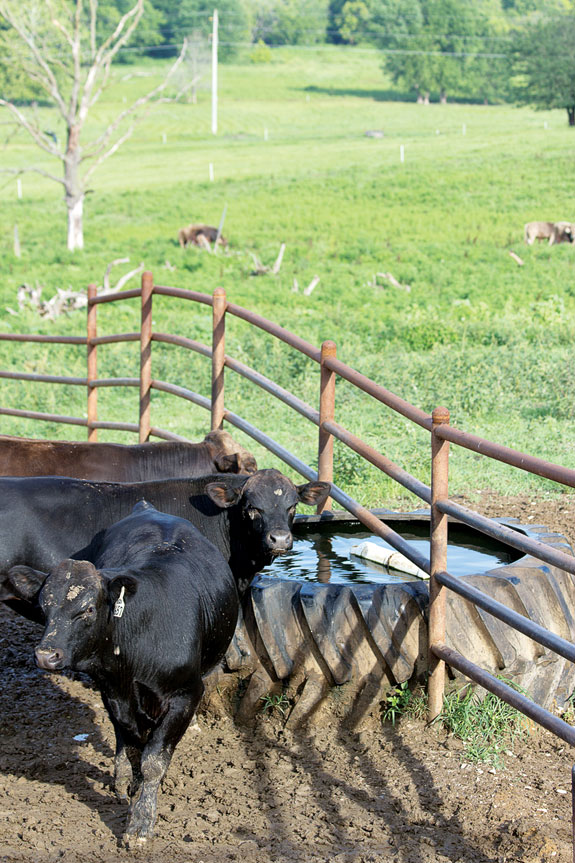“The reason there’s such a small percentage of people doing it today is that the simplicity has never gotten across,” said McBee. “All anyone has to do is build pastures and move cattle around.”
If that sounds almost too easy, McBee says that’s precisely his message. Controlled grazing, or management intensive grazing as it has been called, may not be a child’s game, but for McBee it kind of started that way.
“I told somebody the other day – when I was a kid, 4 or 5, you know how everybody played with Lincoln Logs? You know what I built? Pastures. I took toys and built pastures in the living room and moved the cows around on the carpet.”

The McBee Cattle Co., owned by Ron and his wife, Teri, raises purebred seedstock Braunvieh and hybrid Braunvieh-Angus bulls and females.
The seedstock herd includes 250 registered females and about 200 commercial females, primarily with Braunvieh genetics.
McBee develops around 120 bulls and 150 heifers each year on high-fiber rations. In 2010, the ranch was nominated for Beef Improvement Federation’s Seedstock Producer of the Year.
But the backdrop to the success is 1,500 acres of pasture on rolling hills in central Missouri, a contiguous fabric of land that McBee carefully selected after experimenting with various grazing systems when he was a fencing distributor.
Located in the heart of Missouri’s rich fescue country, the McBee Cattle Co. works on 80 paddocks connected by eight miles of water line to a network of ponds and rubber tire tanks.

Each paddock has two gates in each corner. Each gate is fastened to a pipe post driven five feet in the ground, with three feet above and a welded cap on top.
The paddocks are connected by a 32-foot lane that allows McBee to rotate cattle anywhere in about 15 minutes.
One person can move between paddocks with a four-wheeler, a horse or even a golf cart, to manage each day’s work.
McBee will typically bale 800 to 1,000 big bales from pasture, while trying not to bale the same paddock two years consecutively. The pasture typically produces three bales to the acre, without any fertilizer. “Our only fertilizer is cow,” McBee said.
Trial and error
McBee says his intensive rotation grazing practices evolved “from 25 years of trial and error.” The early strategies were learned from a grazing specialist with the Ministry of Agriculture in New Zealand.
Few producers in the country were using holistic land management practices developed by Allan Savory in Africa, Australia and the U.S. Southwest, which call for increased animal density, mobility and stocking rates to improve grazing vegetation.
Initially, the plan was rough. Starting in 1982, he used 36 paddocks on 60 acres to run 150 yearlings. It had a half-mile-long lane running to each paddock. Cattle would stay on a paddock for 24 hours and be moved.

At the end of the 36-paddock rotation, the first paddock “looked bare like a roadway, and I was out of grass,” McBee recalled.
But after recalculating with his New Zealand source, McBee pored over the grass measurements, days of rain, dates and times.
“It didn’t take him 15 minutes to figure out I left them on each paddock too long,” McBee recalled. “It’s the old take half, leave half deal.
“Except in some cases when grass is growing fast, you move cattle fast, and when grass slows down, you slow the cattle down.
We didn’t do that. We put up a bunch of fences and a bunch of corner posts. But we had the old concept that as long as there’s grass, leave them in there. We left out a pretty important part of the system.”
Other adjustments came over time – among the biggest was the need to take water closer to the herd.
Originally, cattle had to walk a half-mile lane every day to get to centrally located water, wearing the lane out and walking off valuable pounds.
The payoff
Today the McBees’ property consists of 28 fenced ponds, of which two of the larger ones are used to feed water to 60 different permanent tanks.

Each tank is placed between at least two paddocks. Two-inch pipe runs to each tank’s stop and waste valve.
McBee’s crew makes the floats out of four-inch PVC pipe, which is the biggest maintenance item. But without that network, the system would not work near as well.
“To do anything like this, you have to have water,” McBee said of the intensive grazing. “You’ve got to make a decision.
If you take water to them, they’re gonna pay you for it. If you make them walk to it, they’re gonna charge you for it.”
With the right adjustments, the controlled grazing started paying off. “After three years, we figured out we went from 85 pounds of beef per acre to 500.”
The third year is really the payoff year with improved grass, McBee explained. Today some producers are pushing mob grazing, which tends to see a turnaround in grass conditions after one year, he said. “Mob grazing is a different concept than intensive grazing,” he added.
“They’re trying to put 200,000 pounds of animal on an acre for a shorter amount of time. Whatever they don’t eat they’re going to walk on, putting organic matter and carbon back in the ground.”
McBee found mob grazing to work as well, but a difference exists with the recurring quality of the forage.
“Usually by the time they get there, it’s mature fescue.In a mob scenario, you’ve got weeds, and the cows won’t gain as well.”
The stocking density hasn’t changed much in the past 20 years, McBee explained. But the operation did change from a background yearling operation to a seedstock enterprise.
McBee uses only about 10 of his 25 bulls to run with groups that hold between 10 to 20 cows during the breeding season. That small number makes controlled intensive grazing tougher.
“If we can put the whole 200 cows in one group, we can do wonders with controlling the grass.”
Old-school simplicity
The fact that McBee is in a lush area of Missouri that receives 40 inches of rain annually doesn’t change his philosophy that intensive rotational or controlled grazing can work elsewhere.
McBee, over time, has developed three simple rules of thumb to follow that can show maximum results and distinguish your operation from a simple pasture rotation:
■ The eight-paddock minimum – Whether you have 20 acres or 2,000, McBee says, an intensive grazing pasture plan requires you to have at least eight paddocks to make the system work.
“It’s not a four-pasture rotation like they taught us in college,” McBee said. “It’s a step up. It’s like grad school compared to eighth grade.”
■ A four-day maximum – To keep pasture growth steady, it’s critical not to keep any cattle on any grass over four days.
“Three days is better, and two days is better than three, and one is better than two,” McBee said. The faster the grass grows, the more frequently you move the cattle.
This keeps cattle from biting as much of the same grass. “If you take grass below the basal bud, which on most plants is four to five inches, it takes 11 days for that plant to recover and start growing again.”
■ Double your stocking rate – McBee says this is the rule that trips up most graziers, just as it did him at first.
But by doubling the recommended stocking rate, you have enough head to control the vegetation in any given area for a given amount of time.
This allows for a better stimulation of grass growth and, if done right, will give you some acreage for a backup if you make a rookie mistake like he did in 1982.
McBee emphasizes that doubling the stocking rate does not mean buying twice as many cattle. You don’t have to buy more cattle to do this.
Simply divide your pasture acres and only use one-half of it to run the same number of cows. You have doubled your stocking rate without borrowing money. If you don’t need it for grazing, you can stockpile for winter, bale hay or rent it to your neighbor.
To those who complain about the need to control grazing by regularly moving cattle, McBee says if they’re checking cattle daily, they’re already doing the work.
They only need to open the gates. “It’s like a kid going to a candy store,” he said. “They know they’re going to a new plate of food. So just get out of the way.”
The most effort, McBee said, is usually required when setting up the paddocks properly and finding the right water delivery. Now there is help at your local NRCS office for this. Just be sure they “keep it simple,” he said.
“This is the one thing that will add dollars to a producer’s pocket for less capital expenditure than anything else they do,” McBee explained. “Everybody that’s tried it that follows the plan – they’re tickled to death.” ![]()
PHOTOS:
PHOTO 1: The entrance to Ron McBee Cattle Co. in Fayette, Missouri.
PHOTO 2: McBee uses a controlled grazing system that rotates cattle on doubled stock rates.
PHOTO 3: Paddocks have gates with posts driven 5 feet into the ground, and 3 feet above.
PHOTO 4: By doubling his stocking rate Ron McBee has sufficient land left to bale hay, stockpile hay or rent land to a neighbor.
PHOTO 5: Angus hybrids at McBee Cattle Co. are watered by a network of tire tanks.







